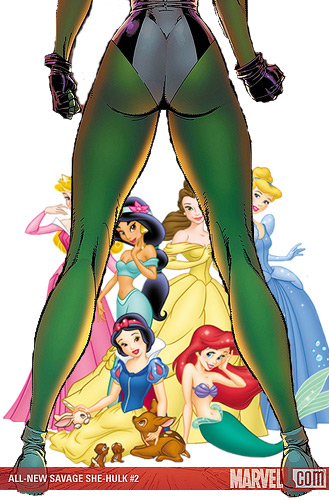Powet alphabet: U is for Ultimate Marvel
by William Talley, filed in Comics, Powet Alphabet on Nov.22, 2010
Since the alphabet is the building block of our language, the Powet Alphabet is the building block of what makes us geeks.
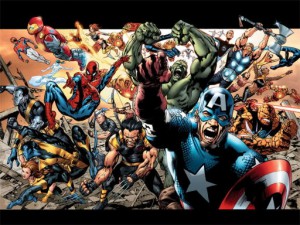
As Marvel Comics emerged into the 21st century, they were also emerging from bankruptcy. Thanks partially to the success of the hugely popular X-Men and Spider-man cartoons, along with Capcom’s widely successful Marvel fighting games, more people were reading the comics more than ever. With a sure-to-be blockbuster X-men movie on the horizon, along with an influx of new readers, things were only looking up for The House of Ideas.
There was only one problem: accessibility. With over 40 years of history behind them (60 if you count their years as Timely/Atlas), it was, to say the least, difficult for the average ‘man on the street’ to pick up a comic book and know what’s going on as well as a hardcore reader would. Heck, look at some of these things. Clones? Alternate Universes? Dystopian future timelines? Resurrections? 4 different versions of limbo? Clones of people from alternate universes battling resurrected people from alternate versions of dystopian timelines (and I’m not exaggerating either. All of these things were in a Marvel storyline at one time or another, often times, more than one at a time). Hardcore readers were having a hard enough time keeping up, so imaging how hard it would be for someone whose X-men and Spider-man knowledge came primarily from the cartoons. However, Marvel devised a solution: Ultimate Marvel.
Aimed at new readers, Ultimate Marvel featured revamped versions of popular Marvel characters, along with new twists on classic Marvel concepts and storylines. It became a hit with new readers, and it even came to be embraced by older readers as well. While most of the core concepts were the same, there were several changes. Some were minimal and were only made in order to make the stories fit in the modern era (for instance, the Spider which bit Peter Parker and gave him his powers was genetically altered rather than radio active, and he worked as the Daily Bugle’s webmaster as opposed to it’s photographer) others were more extreme (instead of being a old grizzled bad-ass white guy, Ultimate Nick Fury was a bad-ass black guy who was a dead ringer for actor Samuel L Jackson). Readers who were new to the Ultimate line had to learn to throw their preconceived notions out the window and forget everything they thought that they know about their favorite characters.
Ultimate Origins
The idea of the Ultimate line started back in 1997, when writer Warren Ellis wrote an article about writers using the past to create new tales and reinvent characters, envisioning a new version of the Fantastic Four. Marvel president Joe Quesada and former Bill Jemas had input in the line’s conception, and writers such as Brian Michael Bendis and Mark Millar were tapped to write stories. Grant Morrison was also involved in the line’s conception and it was rumored that his Marvel Boy limited series was going to be retconned into being the first official Ultimate title (however, this was not the case, as the Marvel Boy book was revealed to be set in Marvel continuity and the No-Varr character introduced in the book played a key role in the Dark Reign story arc). Morrison was even tapped to write Ultimate Fantastic Four, but left Marvel for an exclusivity deal with DC shortly before then. Warren Ellis also contributed to the Ultimate line, as his Ultimate Galactus Trilogy, which introduced the character to the Ultimate line.
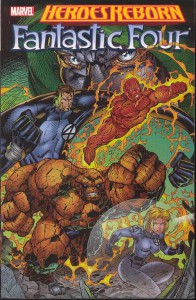
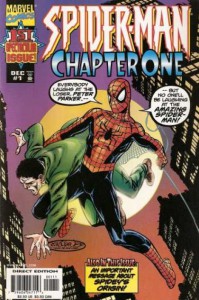
Now some of you may find that this is a bit familiar. That’s because Marvel tried something similar to this a couple of times during the 90s, albeit to mixed reaction. Heroes Reborn saw Captain America, The Avengers, The Fantastic Four, and Iron Man given new modern day origins after they seemingly perished during the ‘Onslaught’ event (actually they were deposited in an artificial universe created by Franklin Richards in one of Marvel many overly complex storylines). Their books were relaunched under Image and were handed to Jim Lee and Rob Liefield. After 13 issues, the line was canceled and the heroes were returned to the Marvel Universe proper. Spidey’s origin saw a revamp of its own in John Bryne’s Chapter One. It wasn’t received very well by fans, as it attempted to overwrite the early Spider-man stories which were written by Lee and Ditko. It was pretty much regulated to non canon status, as not many writers referenced events from the series. Ironically, Bryne said that his book was aimed at new readers, but it was only sold in the direct market (as opposed to magazine racks and bookstores), so those newer readers would have a hard time finding it. Like Heroes Reborn, Chapter One was a failed experiment which caught slack when it attempted to overwrite what has already been established for the sake of new readers. The upcoming Ultimate line would sidestep this issue by having its stories set in an outside universe.
Ultimate Power and Responsibility
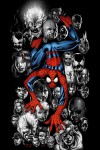 What better way to kick off the line than with Marvel’s flagship hero, Spider-man. Right away, Ultimate Spider-man illustrated the new direction that Marvel took with the character. For long time readers however, the book’s ‘year-one’ style approach would hook them in as well. While the mainstream Spider-Man comics featured a Peter Parker who had to deal with clones, marriage, divorce, symbiotes, and guys who dress up in goblin costumes, this was a younger Peter Parker who was still in high school and was still struggling with girls and bullies, just like the Spidey they enjoyed in their youth. In a way, it was the second coming of the Stan Lee/Steve Ditko Spider-man. Of course there was a bigger focus on characterization, and while the classic Amazing Fantasy 15 story was only 11 pages long, Brian Michael Bendis’s origin was a 7 issue story arc which didn’t even see Spidey take a costume until the 5th issue. Bendis’s focus on characterization made the character even easier to identify with. Who didn’t cheer when Peter blocked bully Flash Thompson’s punch only to break his arm? Of course just like in the mainstream comic series, Peter’s uncle Ben was killed by a burglar he failed to stop. Knowing this didn’t make it any easier to deal with. Classic enemies such as the Kingpin, Green Goblin, Mysterio, Doc Ock, and others showed up (although their origins and looks received some touching up). Key members of Spidey’s supporting cast showed up as well, such as Mary Jane, Harry Osborn, and Gwen Stacy (who in this universe met her end at the hands of Carnage only to be bought back later through cloning). While the mainstream Spidey’s clone saga was a confusing mess that went on for over 3 years, the Ultimate Clone Saga was just another of the book’s story arcs that didn’t screw with the character’s history as much as as the mainstream version of the story did. Ultimate Spidey became an instant hit with fans and readers, even inspiring Activision to create a video game based off Ultimate Spidey. It’s also notable for having the longest writer/artist run in any Marvel Comic with its team of Brian Michael Bendis and Mark Bagley doing 104 issues (sometimes even shipping twice a month!), which was longer than the previous record, Stan Lee and Jack Kriby’s run on the Fantastic Four.
What better way to kick off the line than with Marvel’s flagship hero, Spider-man. Right away, Ultimate Spider-man illustrated the new direction that Marvel took with the character. For long time readers however, the book’s ‘year-one’ style approach would hook them in as well. While the mainstream Spider-Man comics featured a Peter Parker who had to deal with clones, marriage, divorce, symbiotes, and guys who dress up in goblin costumes, this was a younger Peter Parker who was still in high school and was still struggling with girls and bullies, just like the Spidey they enjoyed in their youth. In a way, it was the second coming of the Stan Lee/Steve Ditko Spider-man. Of course there was a bigger focus on characterization, and while the classic Amazing Fantasy 15 story was only 11 pages long, Brian Michael Bendis’s origin was a 7 issue story arc which didn’t even see Spidey take a costume until the 5th issue. Bendis’s focus on characterization made the character even easier to identify with. Who didn’t cheer when Peter blocked bully Flash Thompson’s punch only to break his arm? Of course just like in the mainstream comic series, Peter’s uncle Ben was killed by a burglar he failed to stop. Knowing this didn’t make it any easier to deal with. Classic enemies such as the Kingpin, Green Goblin, Mysterio, Doc Ock, and others showed up (although their origins and looks received some touching up). Key members of Spidey’s supporting cast showed up as well, such as Mary Jane, Harry Osborn, and Gwen Stacy (who in this universe met her end at the hands of Carnage only to be bought back later through cloning). While the mainstream Spidey’s clone saga was a confusing mess that went on for over 3 years, the Ultimate Clone Saga was just another of the book’s story arcs that didn’t screw with the character’s history as much as as the mainstream version of the story did. Ultimate Spidey became an instant hit with fans and readers, even inspiring Activision to create a video game based off Ultimate Spidey. It’s also notable for having the longest writer/artist run in any Marvel Comic with its team of Brian Michael Bendis and Mark Bagley doing 104 issues (sometimes even shipping twice a month!), which was longer than the previous record, Stan Lee and Jack Kriby’s run on the Fantastic Four.
Ultimate X-men
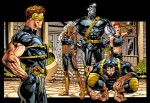 Of course Ultimate X-men was the next on the list. Like in the mainstream Marvel universe, Xavier’s mutants fought for peace between human and mutant. However, this was a younger team that took a more proactive approach to battle. Members of the group were not above killing. While the book was still PG-13 rated so to speak, the series was much more edgier than the cartoon. The opening lineup featured Cyclops, Storm, Jean Grey, Beast, Iceman, Colossus (who was revealed to be gay), with Wolverine joining initially as a mole for Magento’s brotherhood, but eventually coming around to Xavier’s side. X-men regulars such as Psylocke, Angel, Havok, Rogue, and Nightcrawler also show up in the book. The book mostly toned down the extraterrestrial and supernatural elements that were in the mainstream titles. For instance, instead of being a creature from an alternate dimension, Mojo is a television exec in Genosha, and instead of being an alien race, the Shi Ar are a religious cult which worships the Phoenix entity (Phoenix of course only being one of the few more extraterrestrial elements that were allowed to stick, although its origin has been modified). Mark Millar, a Scottish writer wrote the first several storyarcs of the series. Before ultimate X-men, Millar’s only knowledge of the X-men mythos came from the then-recent movie. As it would turn out, who better to write an X-men book for new readers than a writer who himself was new to the X-men? Unlike Ultimate Spider-man which was written strictly by Brian Michael Bendis, Several writers did Ultimate X-Men storyarcs, including Brian K Vaughn (Y The Last Man) and Robert Kirkman (Invincible). Bendis even wrote the book for a year.
Of course Ultimate X-men was the next on the list. Like in the mainstream Marvel universe, Xavier’s mutants fought for peace between human and mutant. However, this was a younger team that took a more proactive approach to battle. Members of the group were not above killing. While the book was still PG-13 rated so to speak, the series was much more edgier than the cartoon. The opening lineup featured Cyclops, Storm, Jean Grey, Beast, Iceman, Colossus (who was revealed to be gay), with Wolverine joining initially as a mole for Magento’s brotherhood, but eventually coming around to Xavier’s side. X-men regulars such as Psylocke, Angel, Havok, Rogue, and Nightcrawler also show up in the book. The book mostly toned down the extraterrestrial and supernatural elements that were in the mainstream titles. For instance, instead of being a creature from an alternate dimension, Mojo is a television exec in Genosha, and instead of being an alien race, the Shi Ar are a religious cult which worships the Phoenix entity (Phoenix of course only being one of the few more extraterrestrial elements that were allowed to stick, although its origin has been modified). Mark Millar, a Scottish writer wrote the first several storyarcs of the series. Before ultimate X-men, Millar’s only knowledge of the X-men mythos came from the then-recent movie. As it would turn out, who better to write an X-men book for new readers than a writer who himself was new to the X-men? Unlike Ultimate Spider-man which was written strictly by Brian Michael Bendis, Several writers did Ultimate X-Men storyarcs, including Brian K Vaughn (Y The Last Man) and Robert Kirkman (Invincible). Bendis even wrote the book for a year.
The Ultimates
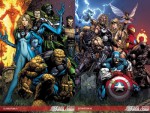 The Ultimates are the Ultimate universe’s version of the Avengers. Created by Nick Fury as a government-sponsored superhero group. This team’s members included the Incredible Hulk (who had gained his powers when trying to duplicate the Super Soldier Serum which created Captain America), Iron Man (Tony Stark, who in this reality contracted a virus while in his mother’s womb and has an inoperable brain tumor), Thor (a self-help new age guru who may be either a god or an escaped mental patient), The Wasp (who was a mutant in the Ultimate universe) and Giant Man (who gained his powers from experimentation using his wife’s cells). When Captain America is discovered frozen in ice, he is revived and joins the team as well. This series was written by Mark Millar and drawn by Bryan Hitch for the first 2 storyarcs. Although the series was berated for shipping late, it was still well received by fans and critics. Well, the first two arcs at least. The third arc, written by Jeph Loeb was a low point for the series and the ultimate line, as it featured a lovesick Ultron killing the Scarlet Witch and making robot duplicates of the Ultimates…and the whole thing was arranged by Doctor Doom!
The Ultimates are the Ultimate universe’s version of the Avengers. Created by Nick Fury as a government-sponsored superhero group. This team’s members included the Incredible Hulk (who had gained his powers when trying to duplicate the Super Soldier Serum which created Captain America), Iron Man (Tony Stark, who in this reality contracted a virus while in his mother’s womb and has an inoperable brain tumor), Thor (a self-help new age guru who may be either a god or an escaped mental patient), The Wasp (who was a mutant in the Ultimate universe) and Giant Man (who gained his powers from experimentation using his wife’s cells). When Captain America is discovered frozen in ice, he is revived and joins the team as well. This series was written by Mark Millar and drawn by Bryan Hitch for the first 2 storyarcs. Although the series was berated for shipping late, it was still well received by fans and critics. Well, the first two arcs at least. The third arc, written by Jeph Loeb was a low point for the series and the ultimate line, as it featured a lovesick Ultron killing the Scarlet Witch and making robot duplicates of the Ultimates…and the whole thing was arranged by Doctor Doom!
Ultimate Fantastic Four
 Ultimate Fantastic Four, also written by Mark Millar, featured a younger version of the foursome, who, along with Dr. Victor Van Damme (Doctor Doom) gained their powers during an excursion to the N-Zone. While the other Ultimate books generally stayed from the cosmic and supernatural, Ultimate Fantastic Four frequently embraced them. They traveled through time, visited alternate universes, and encountered alien life forms. They encountered the ultimate versions of Annilihus (called Nihil), Super Skrull, Thanos, and Galactus among others. In a rather cool twist, they they discovered an alternate dimension that was similar to the Marvel Universe we knew, save for one thing:
Ultimate Fantastic Four, also written by Mark Millar, featured a younger version of the foursome, who, along with Dr. Victor Van Damme (Doctor Doom) gained their powers during an excursion to the N-Zone. While the other Ultimate books generally stayed from the cosmic and supernatural, Ultimate Fantastic Four frequently embraced them. They traveled through time, visited alternate universes, and encountered alien life forms. They encountered the ultimate versions of Annilihus (called Nihil), Super Skrull, Thanos, and Galactus among others. In a rather cool twist, they they discovered an alternate dimension that was similar to the Marvel Universe we knew, save for one thing:
ZOMBIES!
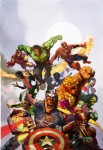 The crossover storyarc which began in UFF 21 hinted at a crossover between the Ultimate and mainstream Marvel Universe (something which Marvel president Joe Quesada said would never happen). It began with Ultimate Reed Richards communicating with an older version of himself resembling the mainstream (dubbed 616) Mr. Fantastic. However, this would be exposed of as a red herring, as this Reed Richards, along with his universe’s version of the Fantastic Four, would be revealed to be zombies. The universe that Ultimate Reed had come in contact with was a universe where all the major superheroes and villains had been infected by a virus which turned them into zombies, forcing them to eat each other along with the millions of uninfected humans on the planet. After the storyarc, the Zombieverse spawned a number of limited series, including a crossover with Ash from Army of Darkness. Of course the Zombieverse wasn’t the only crossover universe that the Ultimate series would see…
The crossover storyarc which began in UFF 21 hinted at a crossover between the Ultimate and mainstream Marvel Universe (something which Marvel president Joe Quesada said would never happen). It began with Ultimate Reed Richards communicating with an older version of himself resembling the mainstream (dubbed 616) Mr. Fantastic. However, this would be exposed of as a red herring, as this Reed Richards, along with his universe’s version of the Fantastic Four, would be revealed to be zombies. The universe that Ultimate Reed had come in contact with was a universe where all the major superheroes and villains had been infected by a virus which turned them into zombies, forcing them to eat each other along with the millions of uninfected humans on the planet. After the storyarc, the Zombieverse spawned a number of limited series, including a crossover with Ash from Army of Darkness. Of course the Zombieverse wasn’t the only crossover universe that the Ultimate series would see…
Ultimate Power
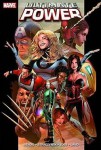 It could be argued that J Michael Straczynski’s Supreme Power series was basically Ultimate Squadron Supreme. The book, which was not under Marvel’s Ultimate imprint but instead launched under Marvel’s Max line (a line geared for mature readers) was a revamp of Mark Gruenwald’s Squadron Supreme series, a book set in an alternate universe which featured a group of super humans patterned after DC’s Justice League. The book was re-branded Squadron Supreme and relaunched under the Marvel Knights line, a more PG-13 rated line of books. Like the Ultimate Universe, Supreme Power did not require any prior knowledge of the source material to enjoy, and was aimed at readers unfamiliar with the original Squadron Supreme. It would make sense that this revamped version of the Squadron Supreme would meet the heroes of the Ultimate Universe, and that’s just what they did in the 9-issue Ultimate Power Series. Written by Straczynski, Loeb, and Bendis, Ultimate Power started out on a strong note, but ultimately wound up a confusing mess, thanks in no small part to several continuity errors, along with the appearance of the Squadron Supreme from the mainstream Marvel comics.
It could be argued that J Michael Straczynski’s Supreme Power series was basically Ultimate Squadron Supreme. The book, which was not under Marvel’s Ultimate imprint but instead launched under Marvel’s Max line (a line geared for mature readers) was a revamp of Mark Gruenwald’s Squadron Supreme series, a book set in an alternate universe which featured a group of super humans patterned after DC’s Justice League. The book was re-branded Squadron Supreme and relaunched under the Marvel Knights line, a more PG-13 rated line of books. Like the Ultimate Universe, Supreme Power did not require any prior knowledge of the source material to enjoy, and was aimed at readers unfamiliar with the original Squadron Supreme. It would make sense that this revamped version of the Squadron Supreme would meet the heroes of the Ultimate Universe, and that’s just what they did in the 9-issue Ultimate Power Series. Written by Straczynski, Loeb, and Bendis, Ultimate Power started out on a strong note, but ultimately wound up a confusing mess, thanks in no small part to several continuity errors, along with the appearance of the Squadron Supreme from the mainstream Marvel comics.
Ultimate Apathy
While the line was all the rage during it’s early years, readers were beginning to disconnect from the line towards the end of the decade. Perhaps it was the many continuity issues that were popping up throughout the different books (despite the fact that only a handful of creators were working on them at a time), the lackluster stories from creators other than Millar and Bendis, or maybe even how dangerously close Marvel came to breaking its ‘no crossover with 616 mandate’ with the Marvel Zombies stories. Or maybe, just maybe, Marvel 616 was starting to be cool again, ironically, thanks in part to the Ultimate Universe’s two main architects, Mark Millar and Brian Michael Bendis. Bendis destroyed the Avengers in the Dissembled crossover, only to reassemble them again in New Avengers. He also had a stellar run on Daredevil, and was the man behind 3 of Marvel’s biggest crossover events: House of M, Secret Invasion, and Siege. Mark Millar, the guy who came in knowing little more of the X-men than what he saw in the movie, took the reins of Wolverine for 13 issues and penned Enemy of the State and Agent of Shield, two of the book’s best storylines. Millar then re-upped with Civil War, the brilliant and controversial storyline which altered the status-quo of the entire Marvel Universe. With the mainstream Marvel titles going so far as to gain media attention for their storylines, it was little wonder few paid attention to the Ultimate books at the time. However, under the direction of writer Jeph Loeb, there was a plan to revitalize the books, and it would start with the end of the world no less.
Ultimatum
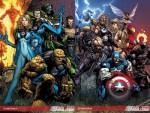 After the dismal Ultimates 3 and the unsatisfying Ultimate Power conclusion, the Ultimate line was hit with an Ultimatum, thanks to Magneto. After his daughter and son were seemingly killed in Ultimates 3, Magneto began a mad plan of revenge against the entire world. By tilting the world on it’s axis, he started a series of disasters which resulted in the deaths of millions…among them being several of the world’s superheroes, including Nightcrawler, the Wasp, and Havok. Before the series was done, Cyclops, Thor, Dr. Strange, and even Wolverine would be among the dead. Around the same time, the three ongoing Ultimate books, X_men, Spider-man, and Fantastic Four also had a storyarc which took place during Ultimatum. Sadly, this series was also a bust as well. Characters and their dialogue were poorly written, some scenes in the book didn’t make any sense if you didn’t read the Ultimatum tie-ins, and the series generally relied on shock value. The series was preceded by Ultimate Origins, a miniseries which attempted to tell the backstory of the Ultimate Universe.
After the dismal Ultimates 3 and the unsatisfying Ultimate Power conclusion, the Ultimate line was hit with an Ultimatum, thanks to Magneto. After his daughter and son were seemingly killed in Ultimates 3, Magneto began a mad plan of revenge against the entire world. By tilting the world on it’s axis, he started a series of disasters which resulted in the deaths of millions…among them being several of the world’s superheroes, including Nightcrawler, the Wasp, and Havok. Before the series was done, Cyclops, Thor, Dr. Strange, and even Wolverine would be among the dead. Around the same time, the three ongoing Ultimate books, X_men, Spider-man, and Fantastic Four also had a storyarc which took place during Ultimatum. Sadly, this series was also a bust as well. Characters and their dialogue were poorly written, some scenes in the book didn’t make any sense if you didn’t read the Ultimatum tie-ins, and the series generally relied on shock value. The series was preceded by Ultimate Origins, a miniseries which attempted to tell the backstory of the Ultimate Universe.
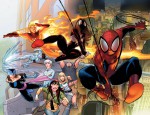 All wasn’t lost for the line however. After a series of books called Requiem, Ultimate Spider-man, Ultimate X-men, and Ultimate Fantastic Four were canceled, and the Ultimate line was relaunched as Ultimate comics. Bendis resumed writing duties on the newly rechristened Ultimate Comics Spider-man, while Mark Millar is writing Ultimate Avengers, a set of miniseries featuring the Avengers, a black ops team whose members include a new Wasp, Hawkeye, and War Machine. Jeph Loeb writes the obscenely late New Ultimates, which features a more public superhero group featuring Captain America, Iron Man, and Valkyrie. Ironically, the Ultimates were intended to be the black ops team while in Marvel 616, the Avengers were the public superheroes. Loeb also writes the also obscenely late Ultimate Comics: X, a series featuring tales of mutants in the post-Ultimatum world. The first issue features Wolverine’s son Jimmy Hudson. Bendis is also engaged in a set of miniseries known as the Ultimate Enemy Trilogy, three 4-issue miniseries which tell of a unknown threat to the heroes of the Ultimate universe.
All wasn’t lost for the line however. After a series of books called Requiem, Ultimate Spider-man, Ultimate X-men, and Ultimate Fantastic Four were canceled, and the Ultimate line was relaunched as Ultimate comics. Bendis resumed writing duties on the newly rechristened Ultimate Comics Spider-man, while Mark Millar is writing Ultimate Avengers, a set of miniseries featuring the Avengers, a black ops team whose members include a new Wasp, Hawkeye, and War Machine. Jeph Loeb writes the obscenely late New Ultimates, which features a more public superhero group featuring Captain America, Iron Man, and Valkyrie. Ironically, the Ultimates were intended to be the black ops team while in Marvel 616, the Avengers were the public superheroes. Loeb also writes the also obscenely late Ultimate Comics: X, a series featuring tales of mutants in the post-Ultimatum world. The first issue features Wolverine’s son Jimmy Hudson. Bendis is also engaged in a set of miniseries known as the Ultimate Enemy Trilogy, three 4-issue miniseries which tell of a unknown threat to the heroes of the Ultimate universe.
Ultimate Impact
 Though the line may have fizzled out, the effects of the Ultimate line are continuing to be felt to this day. Besides forcing the writers of the mainstream Marvel titles to step their game up, it also made Brian Michael Bendis and Mark Millar household names among mainstream comics fans. Marvel released a pair of animated movies called ‘Ultimate Avengers’ which featured the Avengers in their Ultimate costumes. The first movie told the tale of the Avengers banding together to battle an out-of-control Hulk, just like the first arc of the Ultimates. Raven’s Marvel action RPG games, X-men Legends and Marvel Ultimate Alliance featured the characters in their Ultimate costumes, although the stories and characters were inspired by the 616 comics. Activision even released a game based on Ultimate Spider-man. Marvel launched another line, Marvel Age (which was later renamed to Marvel Adventures) which, like the Ultimate line presented stories geared toward new readers. However, this line was geared towards younger readers. Competitor DC comics even got into the habit sort of, as their All Star Superman and All Star Batman and Robin featured tales of their popular heroes written in a manner that was intended to make them accessible to new readers.
Though the line may have fizzled out, the effects of the Ultimate line are continuing to be felt to this day. Besides forcing the writers of the mainstream Marvel titles to step their game up, it also made Brian Michael Bendis and Mark Millar household names among mainstream comics fans. Marvel released a pair of animated movies called ‘Ultimate Avengers’ which featured the Avengers in their Ultimate costumes. The first movie told the tale of the Avengers banding together to battle an out-of-control Hulk, just like the first arc of the Ultimates. Raven’s Marvel action RPG games, X-men Legends and Marvel Ultimate Alliance featured the characters in their Ultimate costumes, although the stories and characters were inspired by the 616 comics. Activision even released a game based on Ultimate Spider-man. Marvel launched another line, Marvel Age (which was later renamed to Marvel Adventures) which, like the Ultimate line presented stories geared toward new readers. However, this line was geared towards younger readers. Competitor DC comics even got into the habit sort of, as their All Star Superman and All Star Batman and Robin featured tales of their popular heroes written in a manner that was intended to make them accessible to new readers.
The entire Ultimate line was a great experience for the comics industry as a whole, as it gave writers free reign to give us an all new look at characters that we grew up with. It served as a great example of how comics, along with other forms of entertainment could reinvent themselves without taking a dump on the source material. At its height, the Ultimate comics bought in an era of unpredictability and uncertainty at a time when the industry was stagnant and constantly rehashing itself.


 PS3
PS3
 Famicom Dojo
Famicom Dojo KEEP PLAYING
KEEP PLAYING KEEP PLAYING: Rewind
KEEP PLAYING: Rewind Powet Toys
Powet Toys Powetcast
Powetcast Hitchhiker's Guide POWETcast
Hitchhiker's Guide POWETcast
















